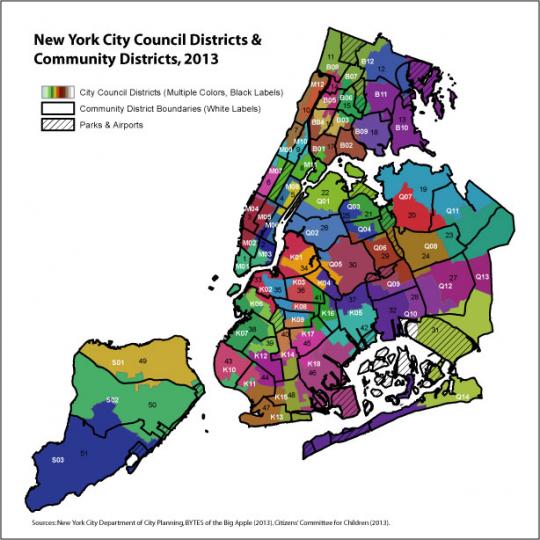Blog
|
March 27, 2013 For Effective Advocacy, Know Your Geography: City Council Districts & Community Districts
Keeping Track includes hundreds of indicators of child well-being at the community level. These data allow advocates, researchers, policymakers, and community members to understand the varying needs of children across New York City. But when we bring Keeping Track to our local City Council Members, they often ask what the numbers mean for their constituents. Most of “community-level” data we collect from city and state agencies, and from other sources like the Census Bureau, are reported at the community district level.[1] But community districts and council districts are not the same. Council districts are political boundaries and must be redrawn every ten years, after each decennial census, to ensure equal representation in city government, in compliance with the constitutional requirement of “one-person, one-vote.” Unfortunately for our local representatives, very few data – beyond basic demographic information – are available at the council district level. Community districts, on the other hand, are administrative districts that exist mainly for community planning purposes. Their boundaries tend to (but don’t always!) follow natural neighborhood dividing lines (think large avenues or park boundaries) and encompass one or more whole neighborhoods. Many city agencies collect and report data by community district for planning purposes. The map above shows the relationship between New York City’s current council districts[2] and the community districts. You can also download a more detailed version of the map that includes a table identifying the council districts and members and their corresponding community districts. Understanding the geography of the data we report is critical to effective advocacy on a local level. We hope you use tools like these, along with the data in Keeping Track, to inform your local advocacy efforts. For more information on how to effectively advocate for New York City’s children, visit the What is Effective Advocacy page on our website. [1] The U.S. Census Bureau reports data at several sub-borough geographies for New York City. The Census-designated Public Use Microdata Areas (PUMAs) roughly approximate the city’s 59 community districts and are used in CCC’s analyses of Census data at the community district level. For more information on the relationship between New York City’s community districts and the Census Bureau’s PUMAs, see the Department of City Planning’s notes on city geographies: http://www.nyc.gov/html/dcp/html/census/geo_notes.shtml. [2] On March 1, the New York City Council adopted a Final District Plan with newly drawn council districts. On March 4, the plan was submitted to the United States Department of Justice for approval under the federal Voting Rights Act. As of the publication of this blog post, the U.S. Department of Justice was accepting public comments on the plan and approval was pending. The new council districts, when approved, will go into effect for the elections to be in 2013. |
Comments |





comments
Please keep all comments civil and on-topic. CCC reserves the right to remove any comments deemed inappropriate.